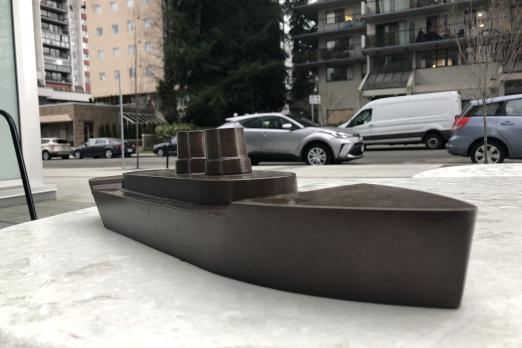This public artwork quietly alludes to the evolution of North Vancouver, with three elements to consider, the creek expressed in the paving pattern, a series of sitting stones and a curious little steam ship.
THE CREEK – Many creeks that once freely flowed through North Vancouver including Mee Creek that, a now-lost waterway that ran parallel to the pedestrian walkway. The memory of this creek acknowledges that the site is on the unceded traditional territory of the Coast Salish Peoples, including the territories of the Skwxwú7mesh (Squamish), and Səl̓ílwətaʔ/Selilwitulh (Tsleil-Waututh) Nations. Prior to European settlement the area was used seasonally by several other nations, and was the permanent site of the Squamish village of Xwemelch’stn (Homulcheson) located at the mouth of the Capilano River.
SITTING STONES – Five sitting stones reflect the area’s raw, pre-settlement condition and the founding five families that built this community from raw materials. Prior to the 1890’s, there was almost no development of the North Shore, with the exceptions of Moodyville and the Squamish village of Eslhá7an (Uslawn). Like many areas surrounding Vancouver, development was stagnated by land speculation. At the time, a handful of wealthy companies or individuals owned all of what is now the City of North Vancouver. Finally, in 1897, five founding families were able to purchase 20 acres of undeveloped land. The plots they chose were bounded by what is now Lonsdale and St Andrews, between 15th and 17th streets - directly adjacent to the project site. This would become the birthplace of the community of North Vancouver.
THE SHIP – The model ship resting at the mouth of the stream has multi-layered significance, acknowledging the cultural historical context of European settlement. It is loosely modeled after the RMS Etruria (a transatlantic ocean liner that sailed for the Cunard Line from 1885-1908), in the style of the battleship Monopoly Token.
The ship alludes to one of the founding families, The Diplock’s whose son records fond memories of playing around Mee Creek:
This stream provided us with a wonderful playground and was a source of never ending enjoyment…. The stream offered all kinds of opportunities for various pastimes such as sailing miniature boats and watching them carried along by the current.
Playfully sailing toy boats down a meandering river is a delightfully innocent act. It is important, however, to consider that boats are cultural artifacts, and as a result carry historical significance. The steamships that carried waves of pioneers to the new world may, in today’s cultural context, not feel so innocent. Likewise, the game of Monopoly is often considered an innocent part of childhood. The race to convert unused real estate into homes, businesses, and hotels seem like priceless fun.
We now understand that colonialism comes at a high cost.
Cement & Bronze
151 East 15th Street
About the Artist
Nantan Lee takes a broad approach to traditional art and design disciplines, applying his formal training in Landscape Architecture to a career in Public Art and Industrial Design. He believes that public art is a unique medium. It is rooted in place, and as a result is a reflection of its cultural and ecological context. Unlike gallery art, whose audience is self-selecting, public art is democratic and open to everyone.






